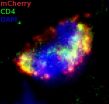(Press-News.org) Most women are infected with HIV through vaginal intercourse, and without effective vaccines or microbicides, women who cannot negotiate condom use by their partners remain vulnerable. How exactly the virus establishes infection in the female reproductive tract (FRT) remains poorly understood. A study published on October 9th in PLOS Pathogens reports surprising results from a study of HIV transmission in the FRT of rhesus macaques.
Most studies of HIV transmission after vaginal exposure to date have been done in rhesus macaques and focused on the cervix, the lower part of the uterus that meets the vagina. Thomas Hope, Daniel Stieh, both from Northwestern University, Chicago, USA, and colleagues went beyond what they call "cervix-centric studies" to take a fresh look at the initial events taking place throughout the FRT that lead to HIV infection.
To do this, they constructed an artificial virus (or vector) that can enter host cells and deliver so-called reporter genes that can label infected cells in the macaque FRT. The vector used the same mechanism of initiating infection in host cells as Simian Immunodeficiency Virus (or SIV, the macaque counterpart of HIV), but it was unable to multiply and spread. It was therefore present only in cells that were directly infected (or "transduced") after introduction of the vector into the vagina.
Instead of generating new virus, the vector expresses two reporter genes, one coding for luciferase (a firefly enzyme that creates the glow of luciferin) and the other for a red fluorescent protein called mCherry. Having two different reporter proteins in infected cells makes it possible to first do a low-resolution scan of the tissue to hone in on areas with infected cells containing luciferase, and then use high-resolution microscopy to visualize the individual infected cells highlighted by mCherry.
Within 48 hours after vaginal introduction of the vector into 8 macaques, the researchers detected infected cells—mostly T cells—throughout the entire FRT, including the vagina, cervix, ovaries, and local lymph nodes. Most animals had more than one site of infection. The most common sites were the vagina and outer cervix, followed by the ovary. Infection in the inner cervix and lymph nodes were each seen in one animal.
Given the limited number of animals and varying stages of the menstrual cycle, the study can't quantify the risk of infection per specific location. However, it indicates that virus can travel throughout the reproductive tract and that sites of initial infection are not restricted to specific domains within the FRT. Based on their findings, the researchers conclude that "the entire FRT should be considered as potentially susceptible to HIV infection, and mechanisms for prevention of HIV acquisition must be present at protective levels throughout the entire FRT to convey protection".
The presence of retroviral infection in the ovary also offers a possible solution to a long-standing mystery, namely how retroviruses can enter the human genome. The decoding of the genome revealed that retroviruses have infected our ancestors repeatedly over evolutionary time, including as recently as 100,000 years ago. Retroviruses are also present in the genomes of all other animal species. To be passed on to the next generation, the retroviruses have to infect germ cells (egg, sperm, or their cellular precursors). Michael Emerman, from the Fred Hutchinson Cancer Center, Seattle, USA, who studies the evolution of the human-retrovirus interaction, and was not involved in the study, commented, "The proof that retroviruses entered into the genome of humans repeatedly in the past is present in every cell in the body of every human. The ability of virus introduced into the vaginal tract to infect cells in the ovary reveals one possible mechanism of how retroviruses could have entered the germ lines of human ancestors".
INFORMATION:
Please contact plospathogens@plos.org if you would like more information about our content and specific topics of interest.
All works published in PLOS Pathogens are open access, which means that published work is immediately and freely available. Use this URL to provide readers access to the paper:
http://dx.plos.org/10.1371/journal.ppat.1004440 (Link goes live upon article publication)
Related Image for Press Use:
http://www.plos.org/wp-content/uploads/2013/05/Hope_OCT_9.jpg
Caption: Infected ovarian cell staining positive for mCherry (red) and the HIV-1 receptor CD4 (green).
Credit: Thomas J. Hope et al., CC BY 2.0
Contact:
Thomas Hope (principal investigator)
e-mail: thope@northwestern.edu
phone: +1.312.503.1360 (office), +1.312.320.6548 (cell)
Daniel Stieh
e-mail: dstieh@northwestern.edu
phone: +1.312.503.1142
Michael Emerman
e-mail: memerman@fhcrc.org
Authors and Affiliations:
Daniel J. Stieh, Northwestern University, USA
Danijela Maric, Northwestern University, USA
Z. L. Kelley, Northwestern University, USA
Meegan R. Anderson, Northwestern University, USA
Holly Z. Hattaway, Northwestern University, USA
Beth A. Beilfuss, Northwestern University, USA
Katharina B. Rothwangl, Northwestern University, USA
Ronald S. Veazey, Tulane National Primate Research Center, USA
Thomas J. Hope, Northwestern University, USA
Funding: This study was supported by the National Institutes of Health grants R01AI094584 and P50GM0825545 to TJH and 1F32HD080540 to DJS. Equipment support was provided by the James B. Pendleton Charitable Trust. Spectral imaging was performed at the Northwestern University Cell Imaging Facility supported by NCI CCSG P30 CA060553 awarded to the Robert H. Lurie Comprehensive Cancer Center. The funders had no role in study design, data collection and analysis, decision to publish, or preparation of the manuscript.
Competing Interests: The authors have declared that no competing interests exist.
Citation: Stieh DJ, Maric D, Kelley ZL, Anderson MR, Hattaway HZ, et al. (2014) Vaginal Challenge with an SIV-Based Dual Reporter System Reveals That Infection Can Occur throughout the Upper and Lower Female Reproductive Tract. PLoS Pathog 10(10): e1004440. doi:10.1371/journal.ppat.1004440
VIDEO:
This video explains research done to understand the motion used by sidewinder snakes to climb sandy slopes and to apply that motion to a snake-like robot. Researchers from Georgia Tech,...
Click here for more information.
The amazing ability of sidewinder snakes to quickly climb sandy slopes was once something biologists only vaguely understood and roboticists only dreamed of replicating. By studying the snakes in a unique bed of inclined sand and using a snake-like robot ...
CANCER RESEARCH UK scientists have discovered that lung cancers can lie dormant for over 20 years before suddenly turning into an aggressive form of the disease, according to a study published in Science* today (Thursday).
The team studied lung cancers from seven patients – including smokers, ex-smokers and never smokers. They found that after the first genetic mistakes that cause the cancer, it can exist undetected for many years until new, additional, faults trigger rapid growth of the disease.
During this expansion there is a surge of different genetic faults ...
When young mice with the rodent equivalent of a rare autism spectrum disorder (ASD), called Rett syndrome, were fed a diet supplemented with the synthetic oil triheptanoin, they lived longer than mice on regular diets. Importantly, their physical and behavioral symptoms were also less severe after being on the diet, according to results of new research from The Johns Hopkins University.
Researchers involved in the study think that triheptanoin improved the functioning of mitochondria, energy factories common to all cells. Since mitochondrial defects are seen in other ...
During their approximately 100-day lifespan in the bloodstream, red blood cells lose membrane surface area, volume, and hemoglobin content. A study publishing this week in PLOS Computational Biology finds that of these three changes, only the observed surface-area loss can be explained by RBCs shedding small hemoglobin-containing vesicles budding off their cells' membrane.
Red blood cell concentration, mean volume, and hemoglobin content are routinely measured in the complete blood count, a fundamental clinical test essential to the screening, diagnosis, and management ...
As birth rates decline in countries that include parts of Europe and East Asia, threatening the economic slowdown associated with aging populations, a global study from the University of California, Berkeley, and the East-West Center in Hawaii suggests that in much of the world, it actually pays to have fewer children. The results challenge previous assumptions about population growth.
Researchers in 40 countries correlated birth rates with economic data and concluded that a moderately low birth rate – a little below two children per woman – can actually ...
A team of scientists including a University of Colorado Boulder professor used NASA's Hubble Space Telescope to make the most detailed global map yet of the glow from a giant, oddball planet orbiting another star, an object twice as massive as Jupiter and hot enough to melt steel.
The Hubble observations show that the planet, called WASP-43b, is no place to call home. It's a world of extremes, where winds howl at the speed of sound from a 3,000-degree-Fahrenheit dayside to a pitch-black nightside when temperatures plunge to a relatively cool 1,000 degrees Fahrenheit, ...
Using X-rays and neutron beams, a team of researchers from the University of California, San Diego School of Medicine, University of Utah and Oak Ridge National Laboratory have teased out new information about Protein Kinase A (PKA), a ubiquitous master switch that helps regulate fundamental cellular functions like energy consumption and interactions with hormones, neurotransmitters and drugs.
"Mutations in PKA can lead to a variety of different human diseases, including cancers, metabolic and cardiovascular diseases and diseases involving the brain and nervous system," ...
Known cancer-driving genomic aberrations in localized lung cancer appear to be so consistently present across tumors that a single biopsy of one region of the tumor is likely to identify most of them, according to a paper published today in Science.
The study led by scientists at The University of Texas MD Anderson Cancer Center addresses the challenge of what scientists call genomic heterogeneity, the presence of many different variations that drive tumor formation, growth and progression, and likely complicate the choice and potential efficacy of therapy.
A landmark ...
A team of scientists using the NASA/ESA Hubble Space Telescope have made the most detailed map ever of the temperature of an exoplanet's atmosphere, and traced the amount of water it contains. The planet targeted for both of the investigations was the hot-Jupiter exoplanet WASP-43b.
WASP-43b WASP-43b is a planet the size of Jupiter but with double the mass and an orbit much closer to its parent star than any planet in the Solar System. It has one of the shortest years ever measured for an exoplanet of its size -- lasting just 19 hours.
A team of astronomers working ...
COLUMBIA, Mo. – As more people in the middle of their careers decide to return to school to further their education, the number of students applying to graduate school programs across the country has reached a record high in the past decade. With record numbers of potential students applying to their programs, many graduate school admissions evaluators are working to develop stronger admissions criteria that assure they are admitting students who will succeed academically. Now, researchers at the University of Missouri have found that traditional measures such as ...



